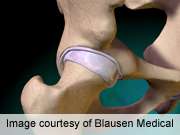FDA probing safety of metal-on-metal hip implants

(HealthDay) -- While thousands of Americans have benefited from hip replacements over the years, problems with metal-on-metal implants can lead to troubles requiring surgery to replace defective devices, experts say.
Specifically, experts say, tiny fragments of metal can shear off from these joints, causing chronic pain or infection and raising levels of metals in the bloodstream. Experts estimate that more than 500,000 Americans have received a metal-on-metal hip joint, mostly between 2003 and 2010.
Worry over the failure rate of the implants, and the speed at which they were initially approved for the U.S. market, has led to a special two-day session, beginning Wednesday, by experts at the U.S. Food and Drug Administration.
"Data from recent studies and from FDA's own review show some patients experiencing complications, including the need for additional surgeries, which could be attributed to metal-on-metal hip implant devices," said FDA spokeswoman Michelle Bolek.
Since 1999, almost 17,000 problems with these devices have been reported to the FDA. Of these, more than 12,000 were reported last year alone.
According to the agency, the problems with metal-on-metal implants are about the same as those seen with polyethylene and ceramic implants, except for the specific risks caused by the metal itself.
But others say that when it comes to complications, metal-on-metal implants are in a class of their own. Writing earlier this month in the New England Journal of Medicine, Dr. Joshua Rising of the Pew Charitable Trusts, and colleagues said that "there is now compelling evidence that these implants fail at a higher rate than hip prostheses made of other materials; indeed, one type of metal-on-metal hip has a failure rate of nearly 50 percent at 6 years."
Responding to these concerns, the FDA panel is considering the risks and benefits of metal-on-metal implants and what might be needed to monitor the health of patients who have them.
Of the estimated 400,000 hip replacements done in the United States each year, 27 percent involve metal-on-metal devices, according to the FDA.
Critics, including an independent panel of experts at the Institute of Medicine, have noted that metal-on-metal implants may have been approved too quickly under the FDA's "fast-track" program for medical devices.
Responding to concerns, in May 2011 the FDA ordered manufacturers to carry out "post-market" studies, tracking the safety of metal-on-metal hip implants in recipients. But in the NEJM article, Rising and colleagues noted that most of these studies have yet to begin and their first results will take years to arrive.
The FDA's Bolek made it clear that the advisory panel meeting is not a regulatory meeting and is not intended to look at the process that brought the devices to the market, or to deal with any planned or current post-marketing studies.
Metal-on-metal devices have already been recalled twice. In 2008, a device from manufacturer Zimmer, the Durom Acetabular Component, was recalled because instructions were not clear.
And in 2010 a device from DePuy Orthopaedics Inc. was recalled because more patients than expected had to have new surgeries, according to the FDA.
Earlier this month, a device called the R3 Acetabular System from Smith & Nephew was taken off the market because the company said it was "not satisfied with the clinical results of this component."
In Europe these concerns have led to calls to ban metal-on-metal hip replacement devices. Writing in March in the journal The Lancet, British researchers concluded that "metal-on-metal stemmed articulations give poor implant survival compared with other options and should not be implanted." Metal-on-metal implants had a five-year failure rate of more than 6 percent, three times higher that seen with ceramic or plastic joints.
Banning metal-on-metal joints isn't an option being considered by the FDA panel at this time.
"During the panel meeting, FDA will discuss failure rates and modes for these devices, as well as any local and systemic complications that could result from metal debris and metal ion levels in the bloodstream from the device," Bolek said.
The panel will also discuss metal ion testing and soft tissue imaging, tools that can potentially be used in the clinical management of patients who have these devices, Bolek said.
"We will also review specific risk factors for specific patient populations and considerations for post-implant follow-up," she added.
Mindy Tinsley is a spokeswoman for metal implant maker DePuy Orthopaedics Inc., which is owned by Johnson & Johnson. She said that "DePuy believes that no single bearing surface meets the needs of all patients, and metal-on-metal implants provide the potential benefit of greater function and a lower risk of dislocation for some patients."
Tinsley also said that all metal-on-metal implants are not alike and they should not be grouped together if problems arise.
One orthopedic expert agreed. Dr. Joshua Jacobs, first vice president of the American Academy of Orthopaedic Surgeons, said that "metal-on-metal devices are not all the same. You have to go down to the individual product to fully understand the result. When you lump metal-on-metal together you miss a lot of important differences."
According to Jacobs, who is chairman of the department of orthopaedic surgery at Rush University Medical Center in Chicago, the advantages of metal-on-metal implants are that there is typically less wear on the joint, leading to less loosening and less bone loss over time.
In addition, he said, metal allows for a thinner, larger socket and head, which makes it less likely the hip will dislocate after surgery, which is a common failure of other types of hip replacement.
Still, given the problems with these devices, Jacobs agrees that patients need to be monitored.
"We are trying to learn the optimal way of monitoring patients with metal-on-metal implants, so we can understand when it is appropriate to intervene," he said. "Right now we are amassing clinical data to understand that better."
More information: For more on hip replacement, visit the American Academy of Orthopaedic Surgeons.
Copyright © 2012 HealthDay. All rights reserved.
















